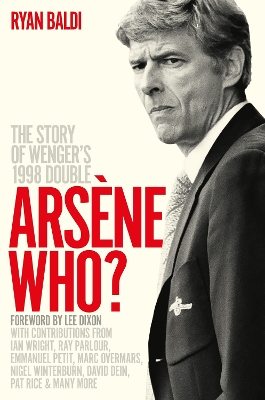
"Wenger’s ingenious orchestration of his 1998 double-winning side is the subject of this fascinating must-read for Gooners, and devotees of the beautiful game."
Featuring interviews with key players, coaches and opponents, and stacks of enlightening anecdotes, Ryan Baldi’s Arsène Who? is a captivating account of Arsenal’s spectacular 1998 double-winning season.
The context is set by Arsenal’s then vice-chairman and co-owner David Dein bagging Arsène for the Gunners. Though Dein couldn’t convince the board to appoint Wenger in the wake of George Graham’s 1995 bung scandal, second time lucky came when Bruce Rioch was sacked after just 431 days.
While Ian Wright instantly warmed to Wenger (“He was just really cool”), and Lee Dixon notes “Arsène gave us all freedom”, other players were less enamoured by Wenger’s arrival, to begin with, at least, with Ray Parlour famously scoffing, “Who the fuck is that?” Wrighty arguably sums up Arsène’s impact best of all, though, telling Baldi, “That love, that’s what he gave us. He brought that feeling of togetherness and love”.
Alongside Arsène’s measured revolution, Arsenal’s longstanding tradition of innovation is threaded through the narrative: “As Wenger walked through Highbury’s famous Marble Halls … he strode across the red cannon that adorned the floor…and noted the bronze bust of Herbert Chapman presiding over the art deco entranceway”. Like Chapman — the visionary, modernising manager who transformed Arsenal and English football from 1925-1934 — Arsène had his own innovations to implement.
For example, as has been widely documented, Wenger wasted no time in instigating a new diet and training regime. “He was a revelation, really”, remarks Dixon in this book. “From day one, his training methods were superb”, praises Ray Parlour. Then came the clout of new signings and the reinvigoration of old hands, giving rise to “Allez les Rouges” being flashed across Highbury’s screens.
While many of anecdotes around Arsène’s arrival are well-known (but what’s not to love about re-living that “serendipitous spark of a lighter” shared between Arsène and Barbara Dein?), Arsène Who? presents a fresh perspective on an exhilarating season, through a winter of discontent. By 11th March 1998, second in the table, nine points behind United with three games in hand, Arsène declared: “I honestly think we can do it. But then perhaps I am a little bit crazy” — a sanguine sentiment that chimes with the “North London forever” optimism that rings round the Emirates today. As such, Arsène Who? has a timely sense of belief and passion.
While banners bearing Arteta-inspired “Vamos!” slogans are a feature of current match days, Arsène’s “Allez les Rouges!” innovation continues to course through the veins of many a true Gooner, and will surely do so for some time, with Ryan Baldi’s Arsène Who? on hand to keep the cannon fire of ‘98 burning bright red and white.
| Primary Genre | Sports |
| Other Genres: |